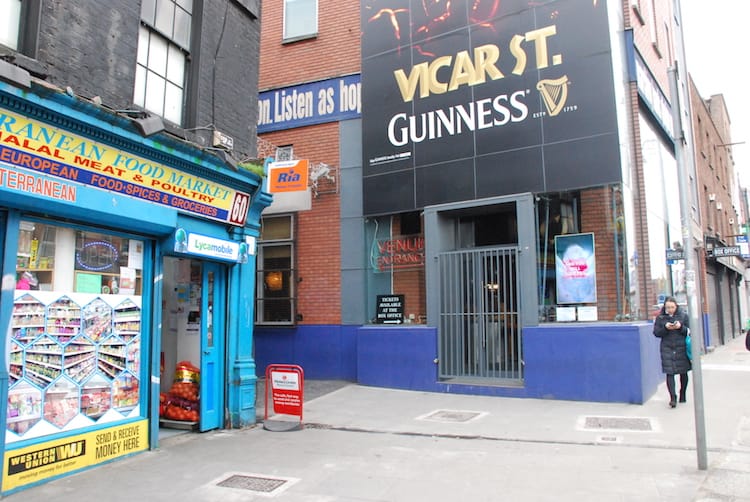What’s the best way to tell area residents about plans for a new asylum shelter nearby?
The government should tell communities directly about plans for new asylum shelters, some activists and politicians say.
If you seek them out in a different corner of the city, you can still see the colourful sculptures that used to stand on Thomas Street.

For the best part of 20 years, three multicoloured heads stood on Thomas Street.
They were markers for those going to Vicar Street, developer Harry Crosbie’s arts and music venue in the Liberties.
Now consigned to a trucking yard at Dublin Port, the Boundary Kings’ best days are behind them. As sculptor Patrick O’Reilly tells it, he’s surprised they lasted this long.
Crosbie – a developer best known for his role in transforming Dublin’s docklands – approached O’Reilly in 1997. It was the halcyon days of the Celtic Tiger. Crosbie was looking ahead to the grand opening of Vicar Street in September 1998.
O’Reilly, who trained at the Belfast College of Art, recalls that vibrancy was the aesthetic of the era. “That style of bright colours was being used a lot at the time,” he says.
He set about creating the three giant faces, which stood on the footpath of Thomas Street until 2014.
Medieval manuscripts like the Book of Kells and the Book of Durrow provided the inspiration, O’Reilly says, the saints and beasts with their multicoloured faces.
O’Reilly painted his three faces in primary colours, with elongated features. More than 10 feet tall, they were hard to miss during their time at Vicar Street.
The Boundary Kings were made using using fibreglass and resin, wrapped and smoothed around wire mesh frames. They arrived on the street in late 1997, where they sat atop three metal poles.
“Weather is huge issue, though. Fibreglass can deteriorate,” says O’Reilly. “It has a certain shelf life.”
There were originally five heads. Two were damaged by the elements. Three survived.

Moved On
The Boundary Kings were always supposed to be temporary. When Dublin City Council officials decided to upgrade the footpaths along Thomas Street in 2014, they had to go.
“It was a collective decision based on the fact that the sculptures were placed at that location on an agreed temporary basis,” said Dublin City Council Public Art Manager Ruairí Ó Cuiv, by email.
“The sculptures did not belong to us, and therefore it was not our option to reinstate them,” he said. That was up to Crosbie.
By this stage, though, the developer was caught up with banks, the courts and the National Asset Management Agency (NAMA) who took control of the Crosbie-owned Bord Gáis Energy Theatre and Point Village Developments in 2013, as reported by The Irish Times in April that year.
Once they had been removed for roadworks, the Boundary Kings were reinstated between the 3 Arena and the Crosbie-built Gibson Hotel in the Docklands for a time, says O’Reilly.
Between then and now, though, they were again removed, this time, to a storage yard at Dublin Port. Crosbie did not wish to comment on the Boundary Kings’ removal or their future.
In March last year, another of O’Reilly’s works that had been commissioned by Crosbie – three eight-foot bronze bears that stood outside the 3 Arena – were also removed, by NAMA.
The Boundary Kings, named for their proximity to the old city limits in the south-west inner city, could have been permanent. But Dublin City Council didn’t go for the idea, says O’Reilly.
At one point, Crosbie proposed that the three heads be set into the pavement. “But it’s very difficult to get planning unless the council themselves have commissioned a work,” says O’Reilly.
Even when it has commissioned a work, the council can face difficulties. To wit: the council debate over its two Luke Kelly statues, one commissioned, one donated.
O’Reilly says he’s unsure what will happen to the giant multicoloured heads into the future. He says he is surprised, though, that they’re still in as good condition as they are, albeit tucked away from the public eye.
“They’re now 20 years old,” says O’Reilly. “Inside, fibreglass will last forever. But outside, especially in Ireland, I’m amazed they’ve lasted this long.”
Our Brushing Up series tells the stories behind pieces of art on display across Dublin, from paintings in pubs to mossy sculptures. So you can pretend you know your art. You can read more of the pieces here.
Get our latest headlines in one of them, and recommendations for things to do in Dublin in the other.